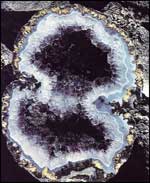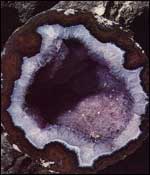Geodes
Scattered throughout the limestone deposits of the world can be found interesting geological phenomena called geodes (GEE-odes), which might be called miniature caves. These geodes are hollow, rounded rocklike or clay objects lined with crystals of various types. Their rough, dull-looking outside surfaces give no clue to the beauty that lies within. Some may look like the petrified eggs of a prehistoric beast, while others more closely resemble mud balls. They may be as small as a walnut or larger than a basketball. Geodes several feet in diameter have been found, but the average is about baseball size.

Example of needlelike rutile crystals
In order for a crystal-lined geode to form, there first must be a cavity or hollow space in the limestone. This cavity may have been formed when a mineral deposit such as iron dissolved, when a buried animal decayed, or when the earth shifted a bit. When ground water carrying dissolved minerals seeps into this resulting cavity, the minerals crystallize on the inner surface. As time passes and more minerals are deposited—new layers growing on old—the hollow interior is almost filled with inward-projecting crystals.

Unusual butterfly calcite formation
Calcite (KAL-site) is the most common mineral found in Texas geodes, and its usual crystal formation is called the dogtooth spar. Most calcite is white, but impurities may tint it other colors. Much of it is fluorescent, and it may appear pink or red under ultraviolet light. The limestone deposits of Central Texas and the Edwards Plateau are good locations to hunt for calcite-filled geodes. A highway cut through a limestone hill may expose buried geodes, but before you go collecting, be sure to get the landowner’s permission. Don’t trespass.

Smoky quartz revealed when a geode is opened
Another crystal that forms in Texas geodes is the brittle celestite (sa-LESS-tite). Celestite crystals are mostly white or colorless near the base where attached, but their tips are a clear blue of gem quality. Since they are brittle, they are very difficult to facet (cut into a gemstone) and are considered unsuitable for jewelry. Fine specimens have been found in geodes near Lampasas and Brownwood and at Mount Bonnell and other localities west of Austin. Celestite geodes, containing little gem-quality material, also have been found in parts of Coke, Fisher, and Nolan counties.

Agate geode
Some of the more colorful geode crystals are quartz, a substance from which many gemstones are formed. Beautiful amethyst is merely purple quartz. The presence of traces of other minerals during the formation period causes the clear quartz crystals to develop in various colors. Quartz can be purple, yellow, rose, blue, smoky gray, or clear.

Agate geode
Often a chalcedony (kal-SED-en-e) layer lies between the inner projecting crystals and the outer geode shell. This chalcedony layer consists of bands of tiny interlocking quartz crystals too small to be easily distinguished under a light microscope. In fact, the structure of this type of quartz is so minutely developed that the material is never able to mature as actual crystals with definite outward shapes. In this banded form, the chalcedony is known as agate. Geodes completely filled with colorful agate have been found.

Quartz geode
In recent years the term geode has been expanded to include the crystal formations found in gas cavities in volcanic rocks. Known as amygdules (ah-MIG-dules), these “geodes” also hold quartz and calcite crystals and layers of chalcedony. Often they are filled almost entirely with banded agate chalcedony, and they range in size from microscopic to about eight inches in diameter. The southern part of the Quitman Mountains in Hudspeth County contains the type of volcanic rocks in which these amygdules form.

Two-foot calcite geode specimen
The next time you go out on a field trip in a limestone area, keep your eyes open for geodes. If you happen to find what you think might be one, there’s only one way to find out—split it open. Many geodes filled with calcite can be broken open with a chisel and hammer, but if you want nice smooth edges and do not want to damage the crystals inside any more than necessary, take the geode to someone who has a diamond saw designed to slice rocks and have the geode cut in half. Whether your geode contains beautiful amethyst or common calcite, you can take pride in having found another example of the hidden beauties of nature.
Ilo
Hiller
1983 Geodes. Young
Naturalist. The
Louise Lindsey Merrick Texas
Environment Series, No.
6, pp. 115-117. Texas A&M
University Press, College
Station.